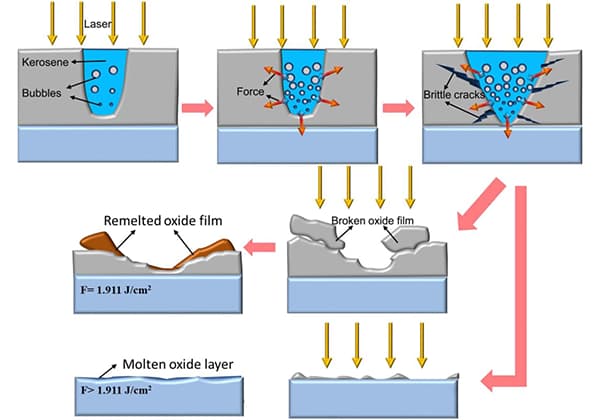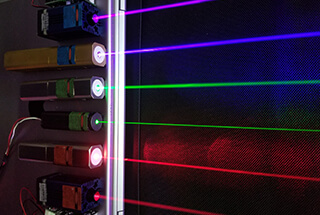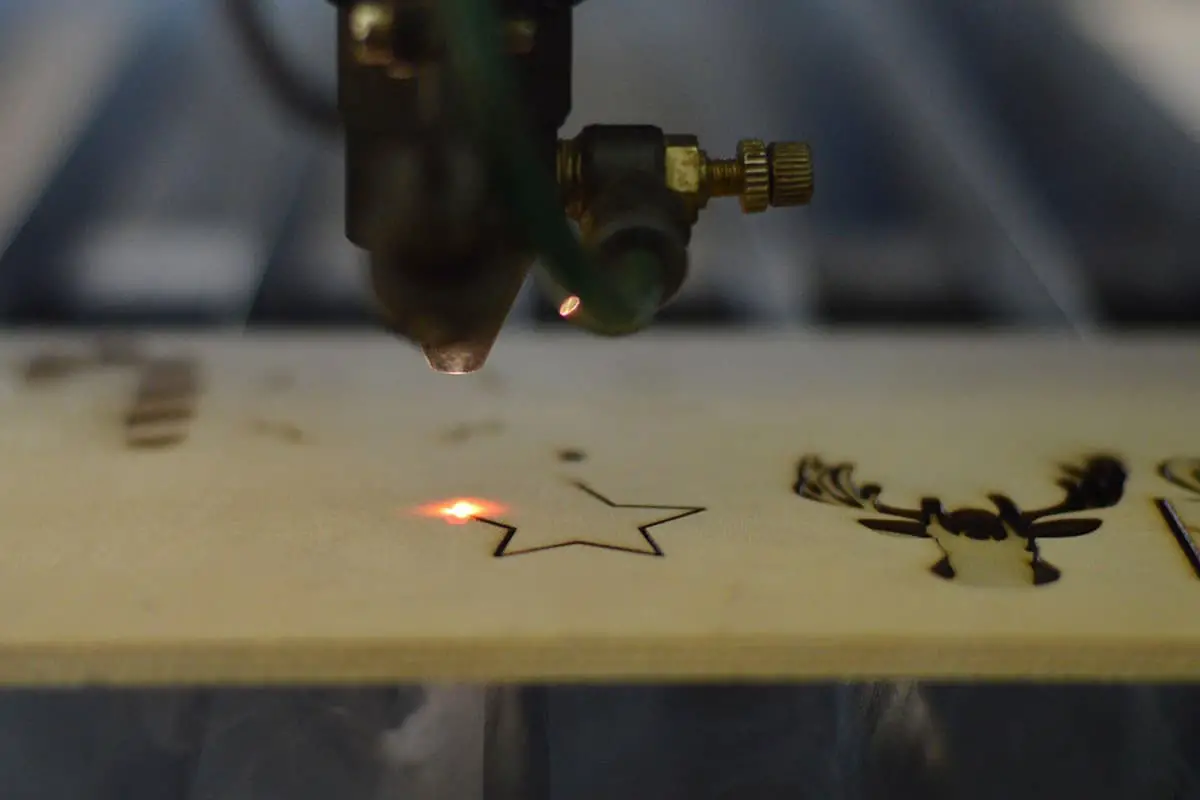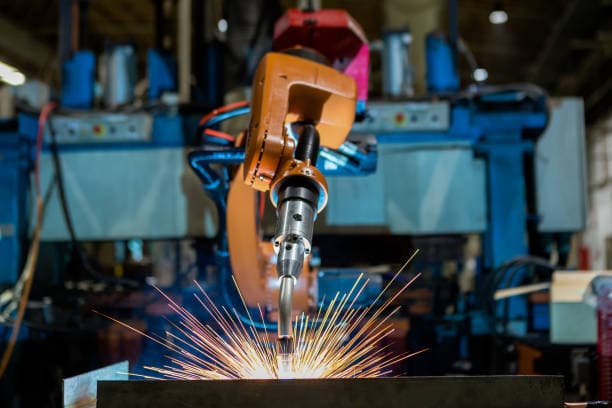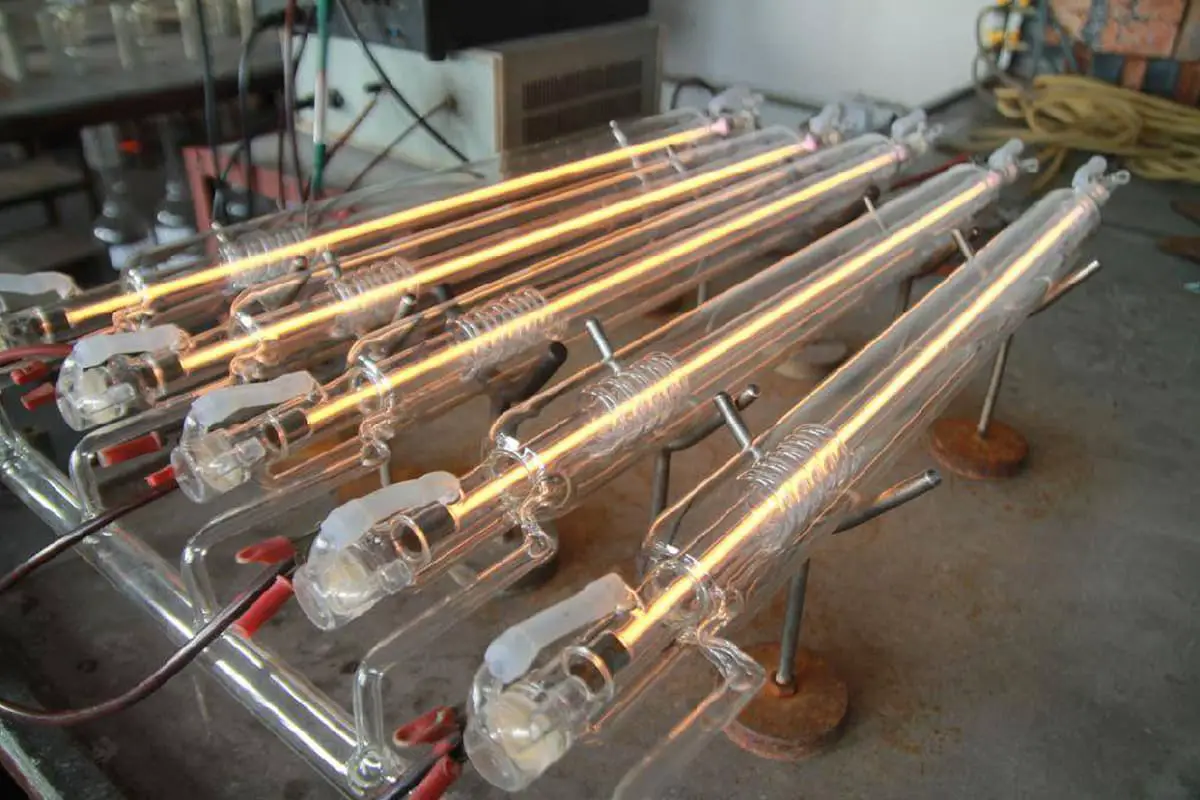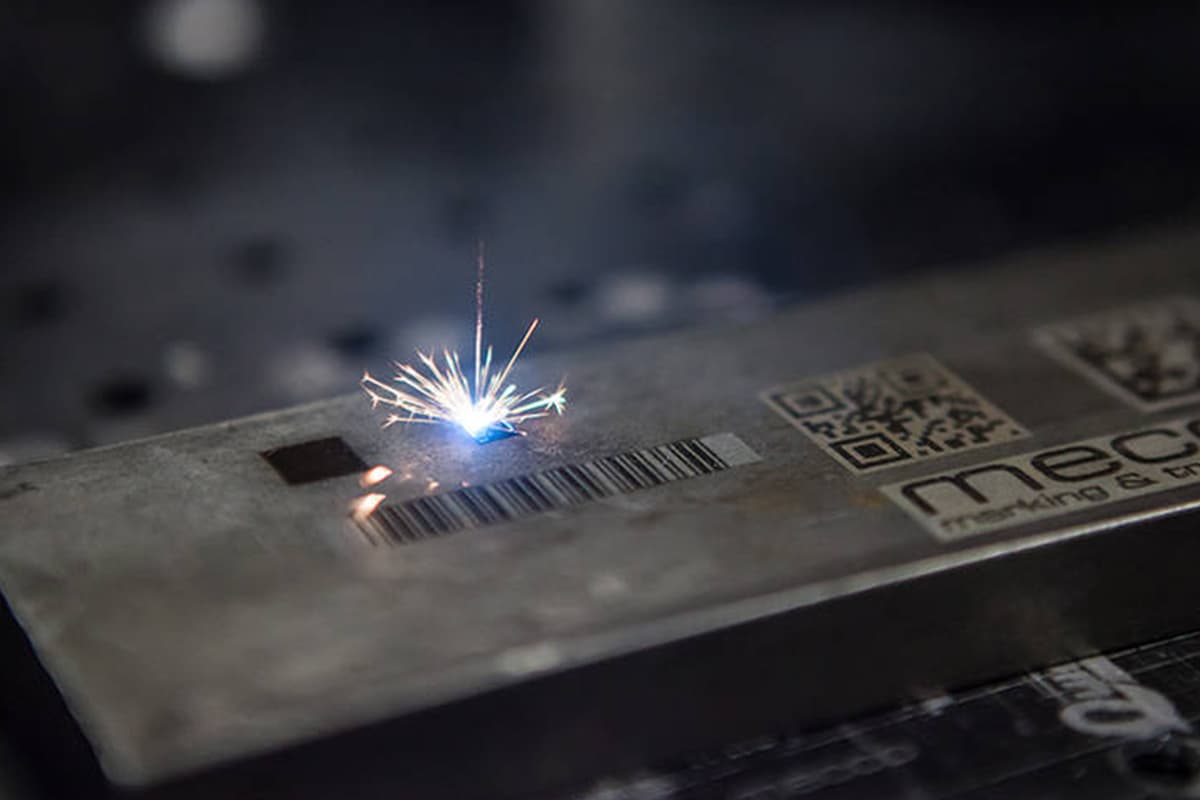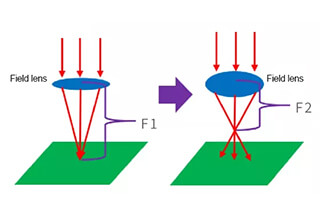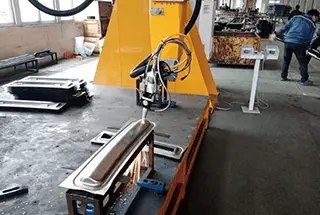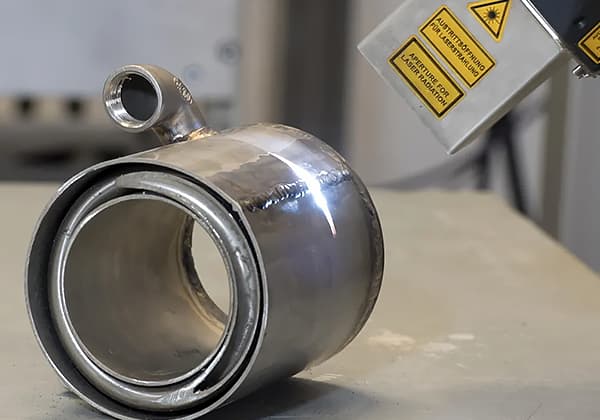
Imagine harnessing the power of light to restore metal surfaces to their original beauty. Laser cleaning is revolutionizing manufacturing, offering a precise, eco-friendly alternative to traditional methods. In this article, our experienced mechanical engineer will introduce you to the fascinating world of laser cleaning technology, explaining its principles, advantages, and diverse applications. Get ready to discover how this innovative approach is transforming the way we maintain and refurbish metal components.
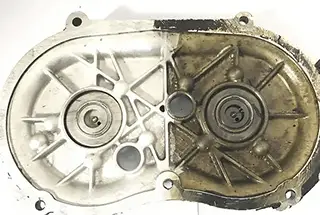
The world’s first laser was developed by American physicist Theodore Harold Maiman using a synthetic ruby crystal in 1960. Since then, lasers have revolutionized numerous fields, catalyzing rapid advancements in medical treatment, precision manufacturing, metrology, and remanufacturing engineering. The proliferation of laser technology has accelerated societal progress and led to significant breakthroughs in cleaning applications across various industries.
Compared to conventional cleaning methods such as mechanical abrasion, chemical etching, and ultrasonic cleaning, laser cleaning offers distinct advantages. It enables fully automated operation with high efficiency, cost-effectiveness, environmental friendliness, substrate preservation, and broad material compatibility. This aligns perfectly with the principles of green manufacturing and sustainable processing, positioning laser cleaning as the most reliable and effective cleaning method currently available in industrial applications.
In the context of remanufacturing and maintenance, cleaning is a critical prerequisite for inspecting and reconditioning used machine components. Laser cleaning technology allows for precise control over surface morphology and roughness while enhancing the substrate’s post-cleaning performance. Its versatility extends to the manufacturing, surface treatment, and remanufacturing of large-scale components, offering unparalleled precision and consistency.
Although laser cleaning has not entirely supplanted traditional methods, the growing emphasis on energy conservation and emissions reduction in the manufacturing sector is driving its adoption. The technology’s unique advantages become increasingly relevant as environmental regulations tighten. Post-2020, China’s more stringent environmental protection laws and heightened safety awareness have limited the use of certain chemicals in industrial cleaning processes. Consequently, the demand for cleaner, non-destructive cleaning methods has intensified.
Laser cleaning stands out for its non-abrasive, non-contact, and thermally neutral approach, suitable for a wide range of materials and geometries. It addresses complex cleaning challenges that conventional methods struggle with, such as selective coating removal, decontamination of sensitive surfaces, and precision cleaning of intricate parts. As industries continue to prioritize sustainability and quality, laser cleaning is poised to become an indispensable technology in advanced manufacturing and maintenance processes.
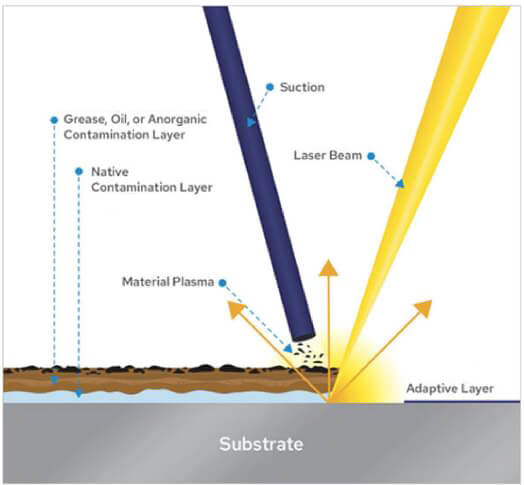
Principle of laser cleaning
When submicron pollution particles adhere to a workpiece surface, they often form tenacious bonds, rendering conventional cleaning methods ineffective. However, cleaning the workpiece surface with nano laser radiation has proven to be highly efficient and precise.
Laser cleaning, being a non-contact method, offers exceptional safety for cleaning precision workpieces and their intricate components while preserving their dimensional accuracy. This unique attribute positions laser cleaning as a superior solution in the cleaning industry, particularly for high-precision applications.
To understand why lasers are effective for cleaning without damaging the substrate, we must first grasp the fundamental principles of laser technology. At its core, a laser is a form of electromagnetic radiation, similar to the light that surrounds us. However, lasers utilize optical resonators to collimate and amplify light in a specific direction, resulting in a beam with significantly higher power density and coherence compared to conventional light sources.
Theoretically, lasers can be generated from any wavelength of light. However, practical limitations in excitable media restrict the range of stable and industrially viable laser sources. Among these, Nd:YAG lasers, CO2 lasers, and excimer lasers have found widespread industrial applications. Nd:YAG lasers, in particular, are favored for their ability to be transmitted through optical fibers, making them especially suitable for diverse industrial cleaning processes.
In scientific terms, laser cleaning is more accurately described as laser ablation. This process involves the removal of material from solid (or occasionally liquid) surfaces through irradiation with a laser beam. The mechanism of material removal depends on the laser flux:
While pulsed lasers are most commonly used for ablation, continuous-wave lasers can also achieve material removal if the intensity is sufficiently high.
For precision optical ablation, deep ultraviolet excimer lasers with wavelengths around 200 nm are predominantly employed. The ablation depth and the quantity of material removed per laser pulse are governed by several factors:
The total mass of material removed by each laser pulse is quantified as the ablation rate. Additionally, laser beam parameters such as scanning speed and line overlap significantly influence the ablation process efficiency and quality.

Effect of laser cleaning tire mould
In the mid-1980s, researchers like Beklemyshev and Alrn pioneered laser cleaning technology by integrating laser systems with traditional cleaning methods to address industrial needs. This innovative approach laid the foundation for the development of laser cleaning as a distinct technical discipline.
The efficacy of laser cleaning is rooted in its ability to overcome the various binding forces between contaminants and substrate materials. These forces include covalent bonds, dipole-dipole interactions, capillary action, and van der Waals forces. By disrupting or surpassing these adhesion mechanisms, laser cleaning achieves effective decontamination.
Laser cleaning leverages the unique properties of laser radiation, including high energy density, precise directionality, and strong focusing capabilities. These characteristics enable the laser to either break the bonding forces between contaminants and the substrate or directly vaporize the contaminants. This process significantly reduces the adhesion strength, facilitating the removal of surface pollutants from the workpiece.
Figure 1 illustrates the schematic principle of laser cleaning.
The mechanism of laser cleaning involves the absorption of laser energy by surface contaminants. This absorbed energy induces rapid vaporization or instantaneous thermal expansion, overcoming the adhesion forces between the contaminant and the substrate. As the thermal energy increases, contaminant particles undergo intense vibration, ultimately detaching from the substrate surface.
The effectiveness of laser cleaning is influenced by several key parameters:
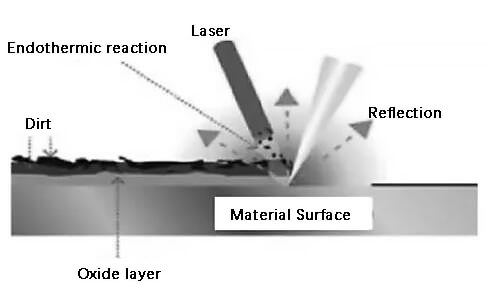
Fig. 1 Schematic diagram of laser cleaning
The laser cleaning process can be divided into four distinct stages:
When implementing laser cleaning technology, it is crucial to consider the laser cleaning threshold of the target material and select the optimal laser wavelength to achieve maximum cleaning efficacy. This threshold is determined by the minimum laser fluence required to initiate the cleaning process without damaging the substrate.
Laser cleaning offers unique advantages in surface modification. It can alter the microstructure and crystallographic orientation of the substrate surface without causing detrimental effects. Furthermore, it enables precise control over surface roughness, which can significantly enhance the overall surface properties, including adhesion, wettability, and wear resistance.
The cleaning effectiveness is primarily influenced by three key factors:
Currently, laser cleaning technology encompasses three main methodologies:
Each methodology offers distinct advantages and is suited for specific applications, depending on the nature of the contaminants and substrate materials.
Pulse laser cleaning is an advanced surface treatment process that utilizes high-intensity laser pulses to remove contaminants from a substrate without the use of chemicals or abrasives. This non-contact method employs a focused laser beam directed at the workpiece, which rapidly increases the energy absorption and temperature of either the substrate or surface pollutants. The resulting thermal effects lead to the efficient removal of unwanted materials.
The process operates through two primary mechanisms:
The effectiveness of pulse laser cleaning depends on careful optimization of laser parameters, including wavelength, pulse duration, energy density, and repetition rate. These factors are tailored to the specific substrate material and contaminant properties, ensuring efficient cleaning while minimizing the risk of substrate damage.
This technique offers several advantages over traditional cleaning methods, including:
Pulse laser cleaning has found applications in various industries, including automotive manufacturing, electronics, cultural heritage preservation, and aerospace component maintenance.
Wet laser cleaning is an advanced surface preparation technique that combines liquid application with pulsed laser irradiation. This process begins by applying a thin liquid film, typically water or a specialized cleaning solution, onto the substrate surface prior to laser treatment.
When the high-energy pulsed laser beam interacts with the liquid film, it causes rapid localized heating and explosive vaporization. This sudden phase change generates a powerful shock wave at the substrate-liquid interface. The resulting mechanical force effectively dislodges contaminants, including stubborn particulates, oxides, and organic residues, from the substrate surface.
The synergistic effect of laser energy and liquid vaporization enhances cleaning efficiency compared to dry laser cleaning methods, particularly for removing sub-micron particles and thin films. Additionally, the liquid film helps to contain and trap ablated contaminants, reducing the risk of redeposition and minimizing airborne particulates.
However, this technique has limitations. The primary constraint is material compatibility; the substrate must be chemically inert to the applied liquid to prevent unwanted reactions or surface degradation. This restricts the range of applicable materials, particularly for reactive metals or water-sensitive substrates. Furthermore, the choice of liquid must consider factors such as surface tension, viscosity, and laser wavelength absorption to optimize the cleaning process.
Despite these challenges, wet laser cleaning offers significant advantages in precision cleaning applications, including semiconductor manufacturing, cultural heritage conservation, and high-value component refurbishment in aerospace and automotive industries.
Laser plasma shock wave cleaning technology harnesses the power of a spherically expanding plasma shock wave generated when high-intensity laser pulses ionize and break down the surrounding air medium. This advanced cleaning method offers several distinct advantages over conventional laser cleaning techniques.
The rapidly propagating shock wave interacts with the substrate surface, imparting kinetic energy to dislodge contaminants without direct laser-substrate contact. This indirect energy transfer mechanism significantly reduces the risk of thermal damage or ablation of the underlying material, making it particularly suitable for sensitive or delicate surfaces.
One of the key strengths of this technology lies in its ability to effectively remove particulate contaminants down to the nanoscale range, typically as small as 10-50 nm. Unlike traditional laser cleaning methods, the efficacy of plasma shock wave cleaning is not constrained by the laser wavelength, allowing for greater flexibility in system design and application.
In industrial applications, optimizing the cleaning process requires careful consideration of various parameters, including:
These parameters should be tailored to the specific substrate material, contaminant type, and cleaning requirements to ensure optimal results.
Evaluating the cleaning efficiency and surface quality is critical for process validation and optimization. Common assessment methods include:
Laser cleaning offers significant advantages over traditional cleaning methods such as mechanical friction, chemical corrosion, liquid-solid impact, and high-frequency ultrasonic cleaning:
2.1 Environmentally Friendly: Laser cleaning is a “green” technology that eliminates the need for chemical agents or cleaning solutions. The waste generated is primarily solid powder, minimal in volume, easily containable, and often recyclable. This addresses the environmental concerns associated with chemical cleaning methods, reducing pollution and hazardous waste management issues.
2.2 Non-Contact Process: Unlike traditional contact-based cleaning methods that can exert mechanical force on the surface, potentially causing damage or leaving residues, laser cleaning is non-abrasive and non-contact. This eliminates the risk of surface damage and secondary contamination, preserving the integrity of the cleaned object.
2.3 Versatility and Accessibility: Laser beams can be transmitted through optical fibers and integrated with robotic systems or manipulators for remote operation. This enables cleaning of hard-to-reach areas and components that are inaccessible to traditional methods. It also enhances operator safety by allowing cleaning operations in hazardous environments without direct human presence.
2.4 Precision and Selectivity: Laser cleaning can effectively remove a wide range of contaminants from various material surfaces with unparalleled precision. It achieves cleanliness levels often unattainable by conventional methods. The process can be finely tuned to selectively remove contaminants without affecting the underlying substrate, making it ideal for delicate or high-value components.
2.5 High Efficiency: Laser cleaning processes are typically faster than traditional methods, significantly reducing cleaning cycle times. This high-speed operation translates to increased productivity and reduced downtime in industrial applications.
2.6 Long-Term Cost-Effectiveness: While the initial investment in a laser cleaning system is considerable, the long-term operational costs are low. These systems offer stable, long-term performance with minimal consumables. Operating expenses are primarily limited to electricity costs, making them economically advantageous over time, especially in high-volume or continuous cleaning applications.
2.7 Automation Potential: Laser cleaning systems can be easily integrated into automated production lines, enhancing process consistency and allowing for in-line cleaning without disrupting manufacturing flow. This integration capability aligns well with Industry 4.0 principles and smart manufacturing initiatives.
The pulsed Nd:YAG laser cleaning process leverages the unique characteristics of the laser’s optical pulse and is fundamentally based on the photophysical reactions occurring at the interface between a high-intensity, short-duration laser beam and the contamination layer.
The underlying physical principles can be delineated as follows:
a) The emitted laser beam is selectively absorbed by the contamination layer on the target surface.
b) This rapid absorption of concentrated energy induces the formation of a high-temperature, rapidly expanding plasma – a highly ionized, unstable gas state. This plasma generation triggers the propagation of shock waves.
c) These shock waves facilitate the fragmentation and subsequent ejection of pollutants from the surface.
d) Critical to this process is the laser’s pulse width, which must be sufficiently short to prevent heat accumulation and potential thermal damage to the underlying substrate.
e) Experimental evidence indicates that in the presence of surface oxides on metals, plasma formation occurs preferentially at the metal-oxide interface.
Plasma generation is initiated only when the laser energy density surpasses a specific threshold, which is contingent upon the properties of the contamination or oxide layer to be removed.
However, if the energy density exceeds a higher threshold, there is a risk of damaging the base material.
To achieve effective cleaning while preserving substrate integrity, precise adjustment of laser parameters is crucial. The optical pulse’s energy density must be carefully controlled to fall within the window between these two thresholds.
Each laser pulse ablates a finite thickness of the contamination layer. For more substantial contamination, multiple pulses are typically required to achieve complete cleaning.
The number of pulses necessary for thorough surface cleaning is directly proportional to the degree of contamination. A key advantage of this dual-threshold mechanism is the inherent self-regulation of the cleaning process.
Laser pulses with energy densities above the lower threshold will continue to remove contaminants until the base material is exposed.
Crucially, as long as the energy density remains below the damage threshold of the substrate material, the cleaning process will automatically terminate without compromising the integrity of the underlying surface.
Laser cleaning is a versatile technique that can effectively remove both organic and inorganic contaminants, such as metal corrosion, metal particles, dust, etc. The following are some practical applications of this technology, which has already reached a high level of maturity and is widely used.
Every year, tire manufacturers around the globe produce hundreds of millions of tires. During the production process, the cleaning of tire molds must be efficient and effective to minimize downtime.
Traditional cleaning methods, such as sandblasting, ultrasonic cleaning, or carbon dioxide cleaning, require the mold to cool for several hours before being transported to the cleaning equipment. This process takes a significant amount of time and can easily compromise the accuracy of the mold. Additionally, the use of chemical solvents and the resulting noise can raise concerns over safety and environmental protection.
The laser cleaning method offers a solution to these challenges. As the laser can be transmitted through optical fiber, it has great flexibility in use. Additionally, the laser cleaning method can be combined with optical fiber to direct the light to hard-to-reach areas of the mold, making it easier to clean. Furthermore, the laser cleaning process does not gasify the rubber, eliminating the risk of toxic gas emissions and ensuring a safe working environment.
The laser cleaning technology for tire molds has been widely adopted in the European and American tire industries.
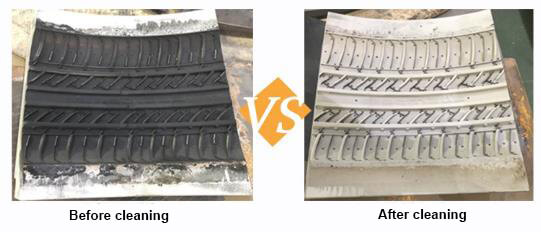
Effect of laser cleaning tire
Although the upfront cost of laser cleaning equipment is high, the benefits of reduced downtime, avoided mold damage, improved safety, and reduced raw material usage can quickly offset this investment.
According to a cleaning test conducted on a tire company’s production line, a set of large truck tire molds can be cleaned online using the laser cleaning equipment in just 2 hours.
Compared to traditional cleaning methods, the economic benefits of using laser cleaning are clear.
In the food industry, the anti-stick elastic film on molds needs to be regularly replaced to maintain hygiene. Laser cleaning, which does not require chemical agents, is also well suited for this application.

Mold cleaning effect
Laser cleaning technology is widely utilized in the maintenance of weapons.
The laser cleaning system is an efficient and quick way of removing rust and contaminants, and it also allows for selective removal, resulting in an automated cleaning process.
Compared to chemical cleaning, laser cleaning not only provides a higher level of cleanliness, but also minimizes surface damage to the objects being cleaned.
Additionally, by adjusting different parameters, a dense oxide protective film or metal melting layer can be formed on metal surfaces, enhancing their strength and resistance to corrosion.
Finally, the waste generated by laser cleaning is environmentally friendly and the process can be performed remotely, reducing the risk of health hazards to operators.
In Europe, laser cleaning systems have been widely used in the aviation industry for a long time.
Aircraft surfaces need to be repainted after a certain period, but before this can happen, the old paint must be completely removed.
Traditional mechanical paint removal methods can easily damage the metal surface of the aircraft and pose a threat to safe flight.
However, by utilizing multiple laser cleaning systems, the paint layer on the surface of an A320 Airbus can be completely removed within two days without causing any damage to the metal surface.
With the rapid growth of China’s economy, more and more skyscrapers are being built, and the challenge of cleaning their exterior walls is becoming increasingly prevalent. The Laserlaste laser cleaning system provides an effective solution for cleaning building exterior walls through optical fibers that are up to 70 meters in length.
This system can effectively clean all types of pollutants from various surfaces such as stone, metal, and glass, resulting in a cleaning efficiency that is several times higher than conventional cleaning methods.
It can also remove black spots and discoloration from various stone materials used in building exteriors.
Experiments using the laser cleaning system on buildings and stone tablets at the Songshan Shaolin Temple have shown that laser cleaning has a highly positive effect in protecting ancient buildings and restoring their appearance.
The electronic industry utilizes laser technology for oxide removal. Precision decontamination is crucial in this industry, making laser oxide removal an ideal solution.
Before welding a circuit board, it is necessary to completely remove any oxides from the component pins to ensure optimal electrical contact. This process must not damage the pins.
Laser cleaning is able to meet these requirements and is highly efficient. In fact, a single pin only needs to be exposed to the laser once for effective decontamination.
In the precision machinery industry, it is often necessary to remove esters and mineral oils used for lubrication and corrosion resistance from parts. This is typically done through chemical methods, but chemical cleaning often leaves residues.
Laser deesterification is an alternative that can completely remove esters and mineral oils without damaging the surface of the parts. This is achieved through the use of a shock wave.
The shock wave is formed by the explosive gasification of the thin oxide layer on the surface of the parts, leading to the removal of pollutants rather than through mechanical interaction.
This method of laser cleaning is widely used in the aerospace industry for thorough deesterification of mechanical parts.
It can also be applied in the machining of mechanical parts to remove oil esters.
The laser cleaning system is also utilized in the cleaning of pipes in nuclear power plant reactors.
By using optical fibers, a high-power laser beam is introduced into the reactor to directly remove radioactive dust, resulting in easy-to-clean materials. Additionally, remote operation ensures the safety of personnel.
In conclusion, laser cleaning plays a crucial role in many fields, including automobile manufacturing, semiconductor wafer cleaning, precision parts processing and manufacturing, military equipment cleaning, building exterior wall cleaning, cultural artifact protection, circuit board cleaning, precision parts processing and manufacturing, LCD cleaning, chewing gum residue removal, and many more.
① Laser Dry Cleaning Method, also known as Direct Radiation Decontamination by Pulsed Laser. This technique utilizes high-energy laser pulses to directly ablate contaminants from the substrate surface without any additional media.
② Laser-Assisted Liquid Film Method involves depositing a thin liquid film on the substrate surface prior to laser irradiation. The liquid enhances the cleaning efficiency by absorbing laser energy and facilitating contaminant removal through localized vaporization and acoustic shock waves.
③ Laser Cleaning with Inert Gas Assist combines laser radiation with a concurrent inert gas flow. As the laser ablates contaminants, the inert gas (typically argon or nitrogen) immediately removes debris, preventing redeposition and oxidation. This method is particularly effective for sensitive surfaces or when working with reactive materials.
④ Laser-Chemical Hybrid Cleaning, primarily used for delicate stone cultural relics, employs laser radiation to loosen contaminants, followed by targeted application of non-corrosive chemical cleaners. This two-step process allows for gentler cleaning of fragile artifacts.
The first three methods are widely adopted in industrial applications, while the fourth is reserved for specialized conservation work.
Laser cleaning technology has been applied to stone materials internationally for over a decade, demonstrating its efficacy in heritage conservation and industrial surface preparation. In China, adoption of laser cleaning for stone materials has been slower, primarily due to the initial high capital costs of laser equipment.
Despite the higher upfront investment, laser cleaning offers significant advantages over traditional methods, including:
As laser technology continues to advance, with improvements in beam quality, power efficiency, and system integration, and as equipment becomes more cost-effective and widely available, laser cleaning is poised to play an increasingly significant role in the stone material cleaning industry. This trend is further supported by growing demands for sustainable and high-precision surface treatment processes across various sectors, from cultural heritage preservation to advanced manufacturing.

